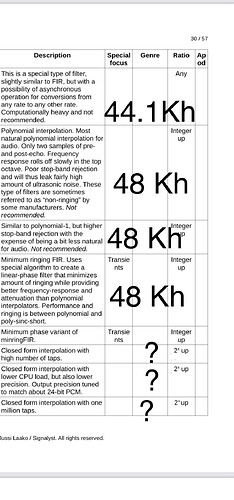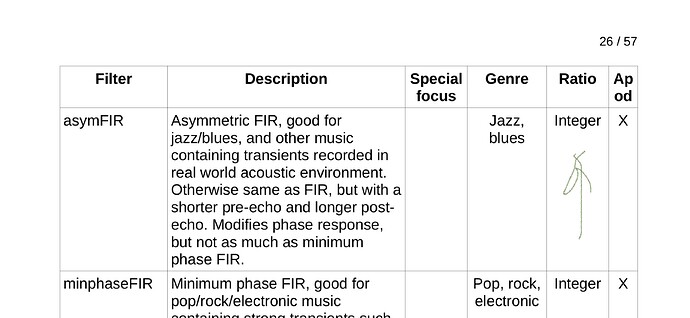Different color palette, and possibly different level scaling. HQPlayer Client has black-green-red-yellow palette. While I believe HQPDcontrol has black-green palette.
Thanks for the explanation, looks are deceiving. To my untrained eye I it looks bad, but it’s not really as you explained.
Any = 44.1 KHz, 48 KHz (any frequency) filter
Integer = 48 KHz, 96 Khz, etc. (integer multiple frequency) filters
2x up = ?? Nx? Any 88 KHz and up ![]() ? (Edith)
? (Edith)
Many thanks
Maybe a dumb question, but when in the signal chain is the 20kHz filter applied? Before or after hqplayer performs its magical up-sampling / dsd modulation? Asked slightly differently, is it a preprocessing of the source material before DSP is applied?
Moy, sorry but I don’t understand you are asking (?).
It is pre-process function, only applied for Nx PCM sources.
About the filter “Ratio” meaning ![]()
Any = 44.1 KHz, 48 KHz (any frequency) filter
Integer = 48 KHz, 96 Khz, etc. (integer multiple frequency) filters
2x up = ?? Nx? Any 88 KHz and up ![]() ? (Edith)
? (Edith)
Any = from any source rate to any output rate (well, at least almost)
Integer = Integer factors, 1x, 2x, 3x, 4x, 5x, 6x…
2^x = Power of two factors, 2x, 4x, 8x, 16x, 32x, 64x, 128x…
So for example:
Any = from 44.1k to 48k, 48k to 176.4k, 352.8k to 96k
Integer = from 44.1k to 88.2k, 88.2k to 352.8k, 192k to 48k, 48k to 144k, 120k to 40k
2^x = 44.1k to 352.8k, 192k to 48k
If it’s “Up”, means only upsampling (up conversion), no decimation (down conversion).
Many thanks!
Like Modulator fifth and seventh orders will work best on different chips like ESS and AKM, will filters work best on different DAC’s?
Sorry for newbie questions!
Hello,
did somebody already compare PCM upsampling with
- ASDM7EC v3, poly-sinc gauss long/poly-sinc hires lp/SDM 48kx256
or - ASDM7EC-super, sinc-MGa/poly-sinc gauss halfband/SDM 48kx256
on a Mac M1?
I am looking forward to share your experiences.
Enjoyed the halfband playing jazz, the guitars are very crispy and detailed.
M1 ok ! DSD256 (not x48)

Filter choice depends mostly on the source content (genre) and personal preferences.
Can Apple Mini M1/M2/Pro or not Pro do DSD512? If so, on what settings?
100%. Despite my tendency to get “wowed” but longer filters for certain tracks, it wasn’t until I discovered HQPlayer that I started to appreciate what different filters bring to the table.
For anyone who has got a high-resolving, punchy set-up, I highly recommend to play the following track - “Rattle the cage” by Flobots - using different filters, I’d suggest the below filters as most of them have been my go-to filters for the most convincing reproduction of all aspects of sound (with some other filters, such as sinc-L, still being able to “wow” me in very specific scenarios/with particular tracks):
- sinc-Mx - big soundstage, there’s some “meat” to the timbre (in a good way), but overall sounds “bloated”, a little plasticky; I’m tempted to say that each of the sounds in isolation sounds great but there’s something missing in terms of making things sound fully cohesive and convincing; despite the big soundstage it’s not as 3D (aka “real”) as I’d like, the “facsimile of sound” effect is still present.
- sinc-MGa - same as above except things get significantly more convincing, interaction between sounds appears more natural, sounds appear to pop out of the background in a more natural way, adding to the 3D effect (depth, but not in absolute terms as in the deepest point of the soundstage, but how sounds interact with each other/how they are presented in relation to each other).
- poly-sinc-gauss-xla - similar to MGa, however slightly less soundstage in absolute terms, but there’s a shift in how much space each sound/instrument is given, which goes a long way to e.g. making drums sound like drums, not like “single points of pressure” (being able to hear the “body” of the sound as opposed to mostly just the “edge” of it - hope this makes sense).
- poly-sinc-gauss long - more intimate, soundstage begins to wrap around my head as opposed to being presented in front of me. Similar to -xla, however, on this track, especially towards the end when the drums are being hit vigorously, I must say there is a significant difference between this filter and its “xla” counterpart. Poly-sinc-gauss-long does not attempt to even try to give the recording orchestra-like presentation, but what it does in terms of focusing on each individual sound and making it sound believable whilst virtually completely getting rid of the “bloatedness” that I always associated this track with - this is nothing short of spectacular.
I picked this track because in most scenarios it has a tendency to sound overdone, bloated. As it turns out, it doesn’t have to be this way.
I refer to sinc-Mx mostly as a reference point for comparisons (it clearly doesn’t do well on this track). What is the most eye-opening is the differences between sinc-MGa, poly-sinc-gauss-xla and poly-sinc-gauss-long because, as I understand it, these are very similar if not identical and the differences are in the length of the filters. Fascinating. The short (successful) quest to find the perfect filter for this particular song has served as a reminder of the first time that I heard the gauss-long filter, which made me go “oh wow, that doesn’t sound digital at all”. Whilst the “xla” version has usually been my go-to filter, I seem to have underappreciated the differences between the two when it comes to certain types of recordings.
Thank you MistaLovaLova for this detailed report! I fully agree that different genres of music are worth trying different filters with sometimes really spectecular effects and anyway: experimenting with the nearly unlimited modulator/filter-collection offered in HQP is pure fun. However I am still looking for the best “alround” modulator/ filter combination, which will certainly not be perfect for all genres, but allowing easy listening at highest level without too many setting-changes. Starting from my default combination in HQP4 - which was ASDM7ECv2, gauss long/hires lp (for Nx), 48kx256 - and after trying out the new modulators and filters in HQP5, I finally landed at ASDM7ECv3, gauss long/gauss halfband (for NX), 48kx256. Perhaps a little bit “old-school” but very nice to listen to.
Hi Everyone,
I’m in the throws of converting all my vinyl to 24/48 flac.
What would you recommend for filters and modulation at DSD256. Any thoughts @jussi_laako
I’m using Vinyl Studio Pro to rip with my Project USB turntable.
Any of your thoughts would be appreciated.
Cheers,
Mark
I would go to at least 24/96…
I’m limited to recording 24/48 over USB and that’s fine. I’m quite happy with CD quality apart from the static which I’m not adjusting to keep the nostalgia of vinyl
Modulator choice is mostly dependent on the DAC in question and your personal preferences.
Also filter choice is mostly depending on personal preferences, but at 48k recording rate, I would certainly use one of the apodizing filters, which are very likely needed with your ADC in this case.


